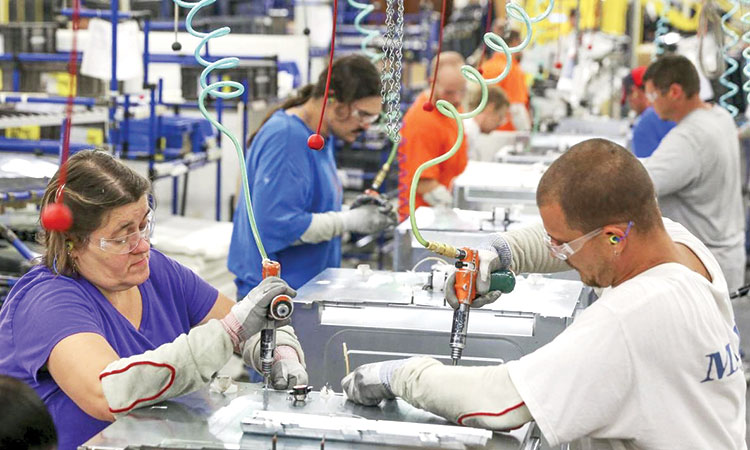US manufacturers improve health benefits for workers

Workers assemble built-in appliances at the Whirlpool factory in Cleveland, Tennessee. Reuters
In the tight labour market of recent years, finding and keeping people has been a challenge. So the company, known for making complex prototypes on deadline, took a step that is becoming increasingly common _ getting more generous with health benefits.
The Minnesota company now pays 97 per cent of medical costs for all manufacturing employees and has brought down the price of its plan for spouses and kids. In 2015, employees paid $6,900 a year and up for a family plan, while today annual premiums run as low as $1,320, or $55 a paycheck.
“I think that people are starting to look at ways that they can be creative,” said Renee Conklin, vice president of human resources. “Again, it isn’t just about money. It’s about how can you be an employer of choice and offer things that are important to employees.”
In a trend that reflects both the strong economy and the growing cost of health care, the Society for Human Resource Management (SHRM), found that 34 per cent of US employers enhanced employee benefits between June 2017 and June 2018, mostly to attract and retain workers. That’s up from 19 per cent in 2016.
Midsize manufacturers say they have felt the pressure particularly acutely, as competition for skilled factory workers is fierce. Pipe-maker Uponor North America, which expanded several times in Apple Valley and Hutchinson, Minn., recently added a free mental-health support services programme to its medical offerings after “recognizing that mental health is just as important as physical health when it comes to engaging employees and recruiting top talent,” said Kara Hayft, Uponor’s vice president for human resources.
Mankato, Minnesota-based V-Tek Inc recently increased health insurance choices for workers and doubled the contribution to each employee’s health savings account from $500 to $1,000 a year.
That “helped us bring in younger workers who were in their 30s or under,” said Christina Hogan, vice president of the 100-employee company that packages semiconductor components for auto, aerospace and medical firms. Young workers liked the higher HSA contribution. Baby boomers liked having more deductible options, Hogan said.
SHRM’s survey found that 51 per cent of organizations that increased benefits improved their health plans, 44 per cent boosted wellness plans and 39 per cent enhanced other programs and services. About 25 per cent of survey respondents improved family medical leave benefits. Others cut health insurance premiums, broadened policy choices, lowered deductibles or stashed more cash into worker’s health savings accounts.
Employers and employees say the changes make a big difference.
When Truly Paw joined Protolabs’ Rosemount, Minn., plant in 2014, the production trainer would have paid five times the premium she pays today to cover her preemie daughter and 4-year-old son. Luckily Protolabs slashed its costs soon after she arrived.
“They have a pretty good health care plan, now. I can afford it at only $55 a check,” Paw said. “If they had kept (the family premiums) at $300 a paycheck, I would never have been able to pay that. I don’t think I would have (stayed). But I think things worked out for me pretty good.”
Nearly three years ago, Alexandria Industries was so pressed to keep and attract skilled workers in its rural region that it opened a free health care clinic for employees _ just a block from one of its three aluminium extrusion plants in Alexandria.
Workers pay nothing for clinic visits. Common prescriptions for infections, the flu, high blood pressure and cholesterol, asthma and diabetes are also free to workers and their families.
The clinic helped slash total health insurance costs and was a “huge” factor in recruiting 88 new hires at a time when retirements had picked up, spokeswoman Patty Hoffman said. The clinic cost $300,000 and paid for itself by February 2018, thanks to added staff, production and sales gains that followed.
“It’s absolutely a tight labour market,” but the clinic “draws people to us,” said Lynette Kluver, Alexandria Industries organizational development director. “The clinic is a game-changer.”
Today, 70 per cent of the 486 workers in Alexandria use the clinic. “It’s so busy we just had to add a full-time clinic administrator” to the two nurses and doctor who run the facility, Hoffman said. Human resource managers from SHRM said many factories are squeezed. While they often pay decent wages, they must keep up with benefits or risk losing their skilled workers to competitors dangling higher wages and incentives.
Tribune News Service







